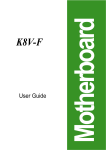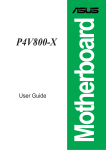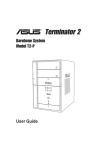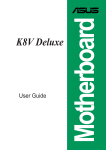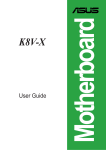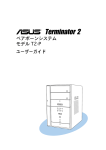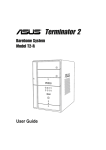Download Asus K8V-F User guide
Transcript
User Guide Motherboard K8V-F E1527 Checklist First Edition V1 January 2004 Copyright © 2004 ASUSTeK COMPUTER INC. All Rights Reserved. No part of this manual, including the products and software described in it, may be reproduced, transmitted, transcribed, stored in a retrieval system, or translated into any language in any form or by any means, except documentation kept by the purchaser for backup purposes, without the express written permission of ASUSTeK COMPUTER INC. (“ASUS”). Product warranty or service will not be extended if: (1) the product is repaired, modified or altered, unless such repair, modification of alteration is authorized in writing by ASUS; or (2) the serial number of the product is defaced or missing. ASUS PROVIDES THIS MANUAL “AS IS” WITHOUT WARRANTY OF ANY KIND, EITHER EXPRESS OR IMPLIED, INCLUDING BUT NOT LIMITED TO THE IMPLIED WARRANTIES OR CONDITIONS OF MERCHANTABILITY OR FITNESS FOR A PARTICULAR PURPOSE. IN NO EVENT SHALL ASUS, ITS DIRECTORS, OFFICERS, EMPLOYEES OR AGENTS BE LIABLE FOR ANY INDIRECT, SPECIAL, INCIDENTAL, OR CONSEQUENTIAL DAMAGES (INCLUDING DAMAGES FOR LOSS OF PROFITS, LOSS OF BUSINESS, LOSS OF USE OR DATA, INTERRUPTION OF BUSINESS AND THE LIKE), EVEN IF ASUS HAS BEEN ADVISED OF THE POSSIBILITY OF SUCH DAMAGES ARISING FROM ANY DEFECT OR ERROR IN THIS MANUAL OR PRODUCT. SPECIFICATIONS AND INFORMATION CONTAINED IN THIS MANUAL ARE FURNISHED FOR INFORMATIONAL USE ONLY, AND ARE SUBJECT TO CHANGE AT ANY TIME WITHOUT NOTICE, AND SHOULD NOT BE CONSTRUED AS A COMMITMENT BY ASUS. ASUS ASSUMES NO RESPONSIBILITY OR LIABILITY FOR ANY ERRORS OR INACCURACIES THAT MAY APPEAR IN THIS MANUAL, INCLUDING THE PRODUCTS AND SOFTWARE DESCRIBED IN IT. Products and corporate names appearing in this manual may or may not be registered trademarks or copyrights of their respective companies, and are used only for identification or explanation and to the owners’ benefit, without intent to infringe. ii Contents Features Notices ........................................................................................... vi Safety information ......................................................................... vii About this guide ............................................................................ viii K8V-F specification summary ......................................................... ix Chapter 1: Product introduction 1.1 1.2 1.3 Welcome! ........................................................................... 1-2 Package contents ............................................................... 1-2 Special features .................................................................. 1-2 1.3.1 Product highlights .................................................. 1-2 1.3.2 ASUS unique features ........................................... 1-4 1.4 Before you proceed ............................................................ 1-5 1.5 Motherboard overview ........................................................ 1-6 1.5.1 Motherboard layout ................................................ 1-6 1.5.2 Placement direction ............................................... 1-7 1.5.3 Screw holes ........................................................... 1-7 1.6 Central Processing Unit (CPU) ........................................... 1-8 1.6.1 Overview ................................................................ 1-8 1.6.2 Installing the CPU ................................................... 1-8 1.7 System memory ............................................................... 1-10 1.7.1 Overview .............................................................. 1-10 1.7.2 Memory configurations ........................................ 1-10 1.7.3 Installing a DIMM ................................................. 1-12 1.7.4 Removing a DIMM ............................................... 1-12 1.8 Expansion slots ................................................................ 1-13 1.8.1 Installing an expansion card ................................ 1-13 1.8.2 Configuring an expansion card ............................ 1-13 1.8.3 PCI slots .............................................................. 1-15 1.8.4 AGP slot ............................................................... 1-15 1.9 Jumpers ............................................................................ 1-16 1.10 Connectors ....................................................................... 1-18 1.10.1 Rear panel connectors ......................................... 1-18 1.10.2 Internal connectors .............................................. 1-19 iii Contents Chapter 2: BIOS Information 2.1 2.2 2.3 2.4 2.5 iv Managing and updating your BIOS .................................... 2-2 2.1.1 Creating a bootable floppy disk ............................. 2-2 2.1.2 Using AFUDOS to copy the current BIOS ............. 2-3 2.1.3 Using AFUDOS to update the BIOS ...................... 2-3 2.1.4 Using ASUS EZ Flash to update the BIOS ............ 2-5 2.1.5 ASUS Update ........................................................ 2-6 BIOS Setup program .......................................................... 2-7 2.2.1 BIOS menu screen ................................................ 2-8 2.2.2 Menu bar ................................................................ 2-8 2.2.3 Navigation keys ..................................................... 2-8 2.2.4 Menu items ............................................................ 2-9 2.2.5 Sub-menu items ..................................................... 2-9 2.2.6 Configuration fields ................................................ 2-9 2.2.7 Pop-up window ...................................................... 2-9 2.2.8 Scroll bar ................................................................ 2-9 2.2.9 General help .......................................................... 2-9 Main menu ........................................................................ 2-10 2.3.1 System Time ........................................................ 2-10 2.3.2 System Date ........................................................ 2-10 2.3.3 Legacy Diskette A ................................................ 2-10 2.3.4 Primary/Secondary IDE Master/Slave .................. 2-11 2.3.5 System Information .............................................. 2-12 Advanced menu ............................................................... 2-13 2.4.1 CPU Configuration ............................................... 2-13 2.4.2 Chipset ................................................................. 2-18 2.4.3 Onboard Devices Configuration ........................... 2-22 2.4.4 PCIPnP ................................................................ 2-24 Power menu ..................................................................... 2-25 2.5.1 ACPI Aware O/S .................................................. 2-25 2.5.2 Suspend Mode ..................................................... 2-25 2.5.3 Repost Video S3 Resume .................................... 2-25 2.5.4 ACPI 2.0 Support ................................................. 2-25 2.5.5 ACPI APIC Support [Enabled] ............................. 2-25 2.5.6 APM Configuration ............................................... 2-26 2.5.7 Hardware Monitor ................................................ 2-28 Contents 2.6 2.7 Boot menu ........................................................................ 2-29 2.6.1 Boot Device Priority ............................................. 2-29 2.6.2 Boot Settings Configuration ................................. 2-30 2.6.3 Security ................................................................ 2-31 Exit menu ......................................................................... 2-33 Chapter 3: Software support 3.1 3.2 Install an operating system ................................................. 3-2 Support CD information ...................................................... 3-2 3.2.1 Running the support CD ........................................ 3-2 3.2.2 Drivers menu ......................................................... 3-3 3.2.3 Utilities menu ......................................................... 3-4 3.2.4 ASUS contact information ...................................... 3-5 v Notices Federal Communications Commission Statement This device complies with Part 15 of the FCC Rules. Operation is subject to the following two conditions: • This device may not cause harmful interference, and • This device must accept any interference received including interference that may cause undesired operation. This equipment has been tested and found to comply with the limits for a Class B digital device, pursuant to Part 15 of the FCC Rules. These limits are designed to provide reasonable protection against harmful interference in a residential installation. This equipment generates, uses and can radiate radio frequency energy and, if not installed and used in accordance with manufacturer’s instructions, may cause harmful interference to radio communications. However, there is no guarantee that interference will not occur in a particular installation. If this equipment does cause harmful interference to radio or television reception, which can be determined by turning the equipment off and on, the user is encouraged to try to correct the interference by one or more of the following measures: • Reorient or relocate the receiving antenna. • Increase the separation between the equipment and receiver. • Connect the equipment to an outlet on a circuit different from that to which the receiver is connected. • Consult the dealer or an experienced radio/TV technician for help. The use of shielded cables for connection of the monitor to the graphics card is required to assure compliance with FCC regulations. Changes or modifications to this unit not expressly approved by the party responsible for compliance could void the user’s authority to operate this equipment. Canadian Department of Communications Statement This digital apparatus does not exceed the Class B limits for radio noise emissions from digital apparatus set out in the Radio Interference Regulations of the Canadian Department of Communications. This class B digital apparatus complies with Canadian ICES-003. vi Safety information Electrical safety • To prevent electrical shock hazard, disconnect the power cable from the electrical outlet before relocating the system. • When adding or removing devices to or from the system, ensure that the power cables for the devices are unplugged before the signal cables are connected. If possible, disconnect all power cables from the existing system before you add a device. • Before connecting or removing signal cables from the motherboard, ensure that all power cables are unplugged. • Seek professional assistance before using an adpater or extension cord. These devices could interrupt the grounding circuit. • Make sure that your power supply is set to the correct voltage in your area. If you are not sure about the voltage of the electrical outlet you are using, contact your local power company. • If the power supply is broken, do not try to fix it by yourself. Contact a qualified service technician or your retailer. Operation safety • Before installing the motherboard and adding devices on it, carefully read all the manuals that came with the package. • Before using the product, make sure all cables are correctly connected and the power cables are not damaged. If you detect any damage, contact your dealer immediately. • To avoid short circuits, keep paper clips, screws, and staples away from connectors, slots, sockets and circuitry. • Avoid dust, humidity, and temperature extremes. Do not place the product in any area where it may become wet. • Place the product on a stable surface. • If you encounter technical problems with the product, contact a qualified service technician or your retailer. vii About this guide Conventions used in this guide To make sure that you perform certain tasks properly, take note of the following symbols used throughout this guide. WARNING: Information to prevent injury to yourself when trying to complete a task. CAUTION: Information to prevent damage to the components when trying to complete a task. IMPORTANT: Information that you MUST follow to complete a task. NOTE: Tips and additional information to aid in completing a task. Where to find more information Refer to the following sources for additional information and for product and software updates. 1. Websites Visit the TARGA® website (www.targa-online.com) to download the latest BIOS for this motherboard. Use ONLY the TARGA® OEM BIOS when updating the motherboard BIOS. Other BIOS updates may corrupt the BIOS ROM. The ASUS websites worldwide provide updated information on ASUS hardware and software products. 2. Optional documentation Your product package may include optional documentation, such as warranty flyers, that may have been added by your dealer. These documents are not part of the standard package. viii K8V-F specification summary for TARGA® PC CPU Socket 754 for AMD Athlon™ 64 processor with built-in L2 cache up to 1MB AMD64 architecture supports simultaneous 32-bit and 64-bit computing Chipset VIA K8T800 VIA VT8237 System bus Scalable HyperTransport™ Bus Memory 2 x 184-pin DDR DIMM sockets for up to 2GB unbuffered non-ECC PC3200/PC2700/PC2100 SDRAM memory Expansion slots 1 x AGP 8X/4X 5 x PCI Storage 2 x UltraATA133 connectors 1 x Floppy disk drive connector Audio Realtek ALC655 6-channel audio CODEC Digital audio via S/PDIF In/Out interface LAN Integrated 10/100 Mbps LAN controller in the southbridge with Realtek RTL8201BL/CL LAN PHY IEEE 1394 VIA VT6307 IEEE 1394 controller supports two 1394 ports Special features ASUS MyLogo ASUS Update Rear panel I/O 1 x Parallel port 1 x Serial port 1 x PS/2 keyboard port 1 x PS/2 mouse port 4 x USB 2.0 ports 1 x IEEE 1394 port 1 x S/PDIF out port 1 x RJ-45 port Line In/Line Out/Microphone ports Internal I/O 2 x USB 2.0 connectors for 4 additional USB ports IEEE 1394 connector for an additional IEEE 1394 port CPU/chassis fan connectors 20-pin/4-pin ATX 12V power connectors CD/AUX connectors S/PDIF In connector Front panel audio connectors Panel connector (Continued on next page) ix K8V-F specification summary for TARGA® PC BIOS features 4Mb Flash EEPROM AMI BIOS with enhanced ACPI, PnP, DMI2.0, Green,TCAV, ASUS EZ Flash Industry standard PCI 2.2, USB 2.0/1.1 Manageability DMI 2.0, WOL/WOR by PME, Wake on USB/KB/Mouse Form Factor ATX form factor: 12 in x 9.6 in (30.5 cm x 24.4 cm) Support CD contents Device drivers ASUS PC Probe ASUS Update Trend Micro™ PC-cillin 2002 anti-virus software Adobe® Acrobat Reader® V5.0 ASUS Screensaver Cool ‘n’ Quiet™ Software Specifications are subject to change without notice. x Chapter 1 This chapter describes the features of this motherboard. It includes brief explanations of the special attributes of the motherboard and the new technology it supports. Product introduction 1.1 Welcome! Thank you for buying the ASUS® K8V-F motherboard! The ASUS K8V-F motherboard delivers a host of new features and latest technologies making it another standout in the long line of ASUS quality motherboards! Before you start installing the motherboard, and hardware devices on it, check the items in your package with the list below. 1.2 Package contents Check your K8V-F package for the following items. ASUS K8V-F motherboard ASUS K8V-F motherboard series support CD I/O shield User Guide If any of the above items is damaged or missing, contact your retailer. 1.3 Special features 1.3.1 Product highlights AMD Athlon™ 64 processor support The K8V-F motherboard comes with a 754-pin surface mount, Zero Insertion Force (ZIF) socket that supports the AMD Athlon™ 64 processor. With an integrated lowlatency high-bandwidth memory controller and a highly-scalable HyperTransport™ technology-based system bus, K8V-F provides a powerful platform for your diverse computing needs. HyperTransport™ features a 16-bit/1.6GHz data transfer rate between the processor and the K8V-F chipset for a total 6.4 GB/s bandwidth. This speeds up the link between computer peripherals and optimizes over-all system performance. See page 1-8. 1-2 Chapter 1: Product introduction VIA K8T800 and VT8237 chipset Embedded in the K8V-F motherboard is the VIA K8T800 and VT8237 chipset. The VIA K8T800 northbridge is a 64-bit processor controller that utilizes the HyperTransport™ bus link to interconnect with the AMD 64 processor. K8T800 supports AGP 8X and communicates with the southbridge chip using the VIA proprietary V-Link interface. The VT8237 southbridge employs the VIA DriveStation™ Controller Suite that enables multiple drive configuration through native Serial ATA, RAID, and Parallel ATA133 support. This chip also supports USB 2.0, IEEE 1394, MC97, Gigabit Ethernet, PCI and LPC interfaces and allows 6 and 7.1-channel audio through the VIA Vinyl Audio technology. DDR400 support The K8V-F features a single memory architecture for up to 2GB system memory. Two 184-pin DIMM sockets are available for installation of unbuffered non-ECC PC3200/2700/2100 DDR DIMMs.See page 1-10. Integrated 10/100 Mbps LAN Onboard is a Realtek 8201BL/CL LAN PHY that works with the integrated MAC in the VT8237 southbridge to fully support 10BASE-T/ 100BASE-TX Ethernet networking. See page 1-18. 6-channel and digital audio solution Providing high-quality, 6-channel audio solution is the Realtek ALC655 Audio CODEC. K8V-F also comes with a rear panel S/PDIF out jack and a S/PDIF in connector at midboard to turn your computer into a high-end entertainment system with digital connectivity to powerful sound systems. See page 1-18 and 1-20. AGP 8X support AGP 8X (AGP 3.0) is the next generation VGA interface specification that enables enhanced graphics performance with high bandwidth speeds of up to 2.12 GB/s. See page 1-15. IEEE 1394 support The IEEE 1394 interface provides high-speed and flexible PC connectivity to a wide range of peripherals and devices compliant to IEEE 1394 standards. The IEEE 1394 interface allows up to 400Mbps transfer rates through simple, low-cost, high-bandwidth asynchronous (real-time) data interfacing between computers, peripherals, and consumer electronic devices such as camcorders, VCRs, printers,TVs, and digital cameras. See page 1-18 and 1-21. ASUS K8V-F motherboard user guide 1-3 USB 2.0 technology The motherboard implements the new Universal Serial Bus (USB) 2.0 specification that increases the connection speed from 12 Mbps on USB 1.1 to a fast 480 Mbps. The higher bandwidth of USB 2.0 allows connection of devices such as high resolution video conferencing cameras, next generation scanners and printers. USB 2.0 is backward compatible with USB 1.1. See page 1-18 and 1-23. 1.3.2 ASUS unique features EZ Flash BIOS With the ASUS EZ Flash, you can easily update the system BIOS even before loading the operating system. No need to use a DOS-based utility or boot from a floppy disk. See page 2-5. MyLogo™ The MyLogo™ feature allows you to personalize and add style to your system with customizable boot logos. See page 2-30. 1-4 Chapter 1: Product introduction 1.4 Before you proceed Take note of the following precautions before you install motherboard components or change any motherboard settings. 1. Unplug the power cord from the wall socket before touching any component. 2. Use a grounded wrist strap or touch a safely grounded object or to a metal object, such as the power supply case, before handling components to avoid damaging them due to static electricity. 3. Hold components by the edges to avoid touching the ICs on them. 4. Whenever you uninstall any component, place it on a grounded antistatic pad or in the bag that came with the component. 5. Before you install or remove any component, ensure that the ATX power supply is switched off or the power cord is detached from the power supply. Failure to do so may cause severe damage to the motherboard, peripherals, and/or components. Onboard LED The K8V-F motherboard comes with a standby power LED. When lit, this green LED (SB_PWR) indicates that the system is ON, in sleep mode, or in soft-off mode, a reminder that you should shut down the system and unplug the power cable before removing or plugging in any motherboard component. SB_PWR K8V-F ® K8V-F Onboard LED ON Standby Power ASUS K8V-F motherboard user guide OFF Powered Off 1-5 1.5 Motherboard overview 1.5.1 Motherboard layout 24.5cm (9.6in) PS/2KBMS T: Mouse B: Keyboard RTL 8201BL PRI_IDE VIA K8T800 Top:Line In Center:Line Out Bottom:Mic In IE1394_1 VIA VT6307 30.5cm (12.0in) Top:RJ-45 Center:USB4 Bottom:USB3 SEC_IDE USBPWR12 USBPWR34 ATX Power Connector COM1 DDR DIMM2 (64 bit,184-pin module) Socket 754 SPDIF_O DDR DIMM1 (64 bit,184-pin module) KBPWR PARALLEL PORT Top:1394 Center:USB2 Bottom:USB1 CPU_FAN ATX12V Accelerated Graphics Port (AGP) VIA VT8237 PCI1 K8V-F CLRTC PCI2 CR2032 3V Lithium Cell CMOS Power CD SPDIF_I FLOPPY PCI3 AUX CHA_FAN PCI4 Super I/O ® USBPWR56 USBPWR78 FP_AUDIO PCI5 BUZZER USB78 1-6 USB56 F_PANEL 4Mbit BIOS SB_PWR ALC655 Chapter 1: Product introduction 1.5.2 Placement direction When installing the motherboard, make sure that you place it into the chassis in the correct orientation. The edge with external ports goes to the rear part of the chassis as indicated in the image below. 1.5.3 Screw holes Place nine (9) screws into the holes indicated by circles to secure the motherboard to the chassis. Do not overtighten the screws! Doing so may damage the motherboard. Place this side towards the rear of the chassis ASUS K8V-F motherboard user guide 1-7 1.6 Central Processing Unit (CPU) 1.6.1 Overview The AMD Athlon™ 64 processor has a gold triangle in one corner. This mark indicates the processor Pin A1 that should match a specific corner of the CPU socket. K8V-F Gold triangle ® K8V-F Socket 754 Incorrect installation of the CPU into the socket may bend the pins and severely damage the CPU! 1.6.2 Installing the CPU Follow these steps to install a CPU. 1. Locate the 754-pin ZIF socket on the motherboard. 1-8 Chapter 1: Product introduction 2. Unlock the socket by pressing the lever sideways, then lift it up to a 90°100° angle. Socket Lever Make sure that the socket lever is lifted up to 90°-100° angle, otherwise the CPU does not fit in completely. 3. Position the CPU above the socket such that the CPU corner with the gold triangle matches the socket corner with a small triangle. 4. Carefully insert the CPU into the socket until it fits in place. Gold triangle The CPU fits only in one correct orientation. DO NOT force the CPU into the socket to prevent bending the pins and damaging the CPU! 5. When the CPU is in place, push down the socket lever to secure the CPU. The lever clicks on the side tab to indicate that it is locked. 6. Install a CPU heatsink and fan following the instructions that came with the heatsink package. 7. Connect the CPU fan cable to the CPU_FAN connector on the motherboard. ASUS K8V-F motherboard user guide 1-9 1.7 System memory 1.7.1 Overview The motherboard comes with two Double Data Rate (DDR) Dual Inline Memory Module (DIMM) sockets. These sockets support up to 2GB system memory using 184-pin PC3200/PC2700/PC2100 unbuffered DDR DIMMs and allow up to 3.2 GB/s data transfer rate. DIMM2 104 Pins DIMM1 The following figure illustrates the location of the DDR DIMM sockets. ® 80 Pins K8V-F K8V-F 184-Pin DDR DIMM Sockets 1.7.2 Memory configurations You may install 64MB, 128MB, 256MB, 512MB and 1GB DDR DIMMs into the DIMM sockets. For optimum compatibility, it is recommended that you obtain memory modules from qualified vendors. See the Qualified Vendors List (QVL) next page. 1-10 Chapter 1: Product introduction Qualified DDR400 DIMMs The following table lists the PC3200 (DDR400) memory modules that have been tested and qualified for use with this motherboard. Obtain DDR DIMMs only from ASUS qualified vendors for better system performance. Table 1: DDR400 Qualified Vendor List (QVL) Size Vendor 512MB 256MB 256MB 256MB 512MB 256MB 512MB 128MB 128MB 256MB 512MB 256MB 256MB 512MB 256MB 256MB 512MB MICRON A-DATA A-DATA A-DATA ATP Brain Power Brain Power Infineon Nanya Nanya Nanya Samsung TwinMOS TwinMOS TwinMOS Winbond Winbond Part Number MT16VDDT6464AG-40BC4 MDOAD5F3G315B1EC2 MDOAD5F3G31YB1EZ2 MDOSS6F3G31JB1EAE AG64L64T8SQC4S B6U808-256M-SAM-400 B6U808-512M-SAM-400 HYS64D16301GU-5-B NT128D64SH4B1G-5T NT256D64S88B1G-5T N512D64S8HB1G-5T M368L3223ETM-CCC M2S9I08AFAPS9F0811A-T M2G9J16AGATT9F081AA4T M2G9I08AFTT9F0811DDT W9425GCDB-5 W9451GCDB-5 * Side/s: DS - Double-sided Chip Brand MICRON A-DATA A-DATA Samsung Samsung Samsung Samsung Infineon Nanya Nanya Nanya SAMSUNG PSC TwinMOS TwinMOS Winbond Winbond Side/s* Chip Number DS SS SS SS DS SS DS SS SS SS DS SS SS DS SS SS DS MT46V32M8TG-5BC ADD8608A8A-5B ADD8608A8A-5B K4H560838D-TCC4 K4H560838D-TCC4 K4H560838D-TCC4 K4H560838D-TCC4 HYB25D256160BT-5B NT5DS16M16BT-5T NT5DS32M8BT-5T NT5DS32M8BT-5T K4H560838E-TCCC A2S56D30ATP TMD7608F8E50D TMD7608F8E50B W942508CH-5 W942508CH-5 SS - Single-sided Visit the ASUS website (www.asus.com) for the latest DDR400 QVL for this motherboard. ASUS K8V-F motherboard user guide 1-11 1.7.3 Installing a DIMM Make sure to unplug the power supply before adding or removing DIMMs or other system components. Failure to do so may cause severe damage to both the motherboard and the components. Follow these steps to install a DIMM. 1. Locate the DIMM sockets in the motherboard. DDR DIMM notch 2. Unlock a DIMM socket by pressing the retaining clips outward. 3. Align a DIMM on the socket such that the notch on the DIMM matches the break on the socket. Unlocked Retaining Clip A DDR DIMM is keyed with a notch so that it fits in only one direction. DO NOT force a DIMM into a socket to avoid damaging the DIMM. 4. Firmly insert the DIMM into the socket until the retaining clips snap back in place and the DIMM is properly seated. Locked Retaining Clip 1.7.4 Removing a DIMM Follow these steps to remove a DIMM. 1. Simultaneously press the retaining clips outward to unlock the DIMM. Support the DIMM lightly with your fingers when pressing the retaining clips. The DIMM might get damaged when it flips out with extra force. 1-12 Chapter 1: Product introduction 1.8 Expansion slots In the future, you may need to install expansion cards. The following sub-sections describe the motherboard slots and the expansion cards that they support. Make sure to unplug the power cord before adding or removing expansion cards. Failure to do so may cause you physical injury and damage motherboard components. 1.8.1 Installing an expansion card Follow these steps to install an expansion card. 1. Before installing the expansion card, read the documentation that came with it and make the necessary hardware settings for the card. 2. Remove the system unit cover (if your motherboard is already installed in a chassis). 3. Remove the bracket opposite the slot that you intend to use. Keep the screw for later use. 4. Align the card connector with the slot and press firmly until the card is completely seated on the slot. 5. Secure the card to the chassis with the screw you removed earlier. 6. Replace the system cover. 1.8.2 Configuring an expansion card After installing the expansion card, configure the card by adjusting the software settings. 1. Turn on the system and change the necessary BIOS settings, if any. See Chapter 4 for information on BIOS setup. 2. Assign an IRQ to the card. Refer to the tables on the next page. 3. Install the software drivers for the expansion card. ASUS K8V-F motherboard user guide 1-13 Standard Interrupt Assignments IRQ Priority Standard Function 0 1 System Timer 1 2 Keyboard Controller 2 N/A Programmable Interrupt 4* 12 Communications Port (COM1) 5* 13 Sound Card (sometimes LPT2) 6 14 Floppy Disk Controller 7* 15 Printer Port (LPT1) 8 3 System CMOS/Real Time Clock 9* 4 ACPI Mode when used 10* 5 IRQ Holder for PCI Steering 11* 6 IRQ Holder for PCI Steering 12* 7 PS/2 Compatible Mouse Port 13 8 Numeric Data Processor 14* 9 Primary IDE Channel 15* 10 Secondary IDE Channel These IRQs are usually available for ISA or PCI devices. * IRQ assignments for this motherboard PCI slot 1 PCI slot 2 PCI slot 3 PCI slot 4 PCI slot 5 Onboard 1394 AGP slot Onboard audio INT A shared –– –– –– shared shared shared –– INT B –– shared –– –– –– –– –– –– INT C –– –– shared –– –– –– –– shared INT D –– –– –– shared –– –– –– –– When using PCI cards on shared slots, ensure that the drivers support “Share IRQ” or that the cards do not need IRQ assignments. Otherwise, conflicts will arise between the two PCI groups, making the system unstable and the card inoperable. 1-14 Chapter 1: Product introduction 1.8.3 PCI slots The PCI slots support LAN, SCSI, USB, and other PCI cards that comply with PCI specifications. The figure below shows a LAN card installed on a PCI slot. 1.8.4 AGP slot The Accelerated Graphics Port (AGP) slot supports AGP 8X (AGP 3.0) specification. Note the notches on the card golden fingers to ensure that they fit the AGP slot on your motherboard. Install only 1.5V AGP cards on this motherboard! 3.3V AGP cards are not supported in this motherboard. K8V-F ® Keyed for 1.5v K8V-F Accelerated Graphics Port (AGP) ASUS K8V-F motherboard user guide 1-15 1.9 Jumpers 1. Clear RTC RAM (CLRTC) This jumper allows you to clear the Real Time Clock (RTC) RAM in CMOS. You can clear the CMOS memory of date, time, and system setup parameters by erasing the CMOS RTC RAM data. The RAM data in CMOS, that include system setup information such as system passwords, is powered by the onboard button cell battery. To erase the RTC RAM: 1. Turn OFF the computer and unplug the power cord. 2. Remove the onboard battery. 3. Move the jumper cap from pins 1-2 (default) to pins 2-3. Keep the cap on pins 2-3 for about 5~10 seconds, then move the cap back to pins 1-2. 4. Replace the battery. 5. Plug the power cord and turn ON the computer. 6. Hold down the <Del> key during the boot process and enter BIOS setup to re-enter data. CLRTC K8V-F ® K8V-F Clear RTC RAM 2 1 Normal (Default) 3 2 Clear CMOS 2. Keyboard power (3-pin KBPWR) This jumper allows you to enable or disable the keyboard wake-up feature. Set this jumper to pins 2-3 (+5VSB) if you wish to wake up the computer when you press a key on the keyboard (the default value is [Disabled]). This feature requires an ATX power supply that can supply at least 1A on the +5VSB lead, and a corresponding setting in the BIOS (see section 2.5.5 APM Configuration). 1-16 Chapter 1: Product introduction KBPWR 1 2 2 3 +5V (Default) +5VSB K8V-F ® K8V-F Keyboard Power Setting 3. USB device wake-up (3-pin USBPWR12, USBPWR34, USBPWR56, USBPWR78) Set these jumpers to +5V to wake up the computer from S1 sleep mode (CPU stopped, DRAM refreshed, system running in low power mode) using the connected USB devices. Set to +5VSB to wake up from S3 sleep mode (no power to CPU, DRAM in slow refresh, power supply in reduced power mode). All jumpers are set to pins 1-2 (+5V) by default because not all computers have the appropriate power supply to support this feature. The USBPWR12 and USBPWR34 jumpers are for the rear USB ports. The USBPWR56 and USBPWR78 jumpers are for the internal USB header that you can connect to the front USB ports. USBPWR12 USBPWR34 1 2 +5V (Default) 2 3 +5VSB USBPWR56 USBPWR78 K8V-F 1 2 2 3 ® K8V-F USB Device Wake Up +5V (Default) +5VSB • The USB device wake-up feature requires a power supply that can provide 500mA on the +5VSB lead for each USB port. Otherwise, the system would not power up. • The total current consumed must NOT exceed the power supply capability (+5VSB) whether under normal condition or in sleep mode. ASUS K8V-F motherboard user guide 1-17 1.10 Connectors This section describes and illustrates the rear panel and internal connectors on the motherboard. 1.10.1 Rear panel connectors 1 2 3 4 5 6 7 12 11 10 9 8 1. PS/2 mouse port. This green 6-pin connector is for a PS/2 mouse. 2. IEEE 1394 port. This 6-pin 1394 port connects provides high speed connectivity for audio/video devices, storage peripherals, or PCs. 3. Parallel port. This 25-pin port connects a parallel printer, a scanner, or other devices. 4. RJ-45 port. This port allows connection to a Local Area Network (LAN) through a network hub. 5. Line In port. This Line In (light blue) port connects a tape player or other audio sources. In 4/6-channel mode, the function of this port becomes Rear Speaker Out. 6. Line Out port. This Line Out (lime) port connects a headphone or a speaker. In 4/6-channel mode, the function of this port becomes Front Speaker Out. 7. Microphone port. This Mic (pink) port connects a microphone. In 6-channel mode, the function of this port becomes Bass/Center Speaker. The functions of the Line Out, Line In, and Microphone ports change when you select the 4- or 6-channel audio configuration as shown in the following table. Audio ports function variation Audio ports Light Blue Lime Pink Headphone /2-Channel Line In Line Out Mic In 4-Channel Rear Speaker Out Front Speaker Out Mic In 6-Channel Rear Speaker Out Front Speaker Out Bass/Center 8. USB 2.0 ports 3 and 4. These two 4-pin Universal Serial Bus (USB) ports are available for connecting USB 2.0 devices. 1-18 Chapter 1: Product introduction 9. Serial port. This 9-pin COM1 port is for pointing devices or other serial devices. 10. S/PDIF port. This port connects to external audio output devices. Use 75 ohm impedance matched coaxial cables for your S/PDIF connection. 11. USB 2.0 ports 1 and 2. These two 4-pin Universal Serial Bus (USB) ports are available for connecting USB 2.0 devices. 12. PS/2 keyboard port. This purple connector is for a PS/2 keyboard. 1.10.2 Internal connectors 1. Floppy disk drive connector (34-1 pin FLOPPY) This connector supports the provided floppy drive ribbon cable. After connecting one end to the motherboard, connect the other end to the floppy drive. (Pin 5 is removed to prevent incorrect insertion when using ribbon cables with pin 5 plug). PIN 1 FLOPPY NOTE: Orient the red markings on the floppy ribbon cable to PIN 1. K8V-F ® K8V-F Floppy Disk Drive Connector 2. Internal audio connectors (4-pin CD, AUX) These connectors allow you to receive stereo audio input from sound sources such as a CD-ROM, TV tuner, or MPEG card. CD (Black) AUX (White) Left Audio Channel Ground Right Audio Channel Ground Left Audio Channel ® Right Audio Channel K8V-F K8V-F Internal Audio Connectors ASUS K8V-F motherboard user guide 1-19 3. IDE connectors (40-1 pin PRI_IDE, SEC_IDE) This connector supports the provided UltraATA133 IDE hard disk ribbon cable. Connect the cable’s blue connector to the primary (recommended) or secondary IDE connector, then connect the gray connector to the UltraATA133 slave device (hard disk drive) and the black connector to the UltraATA133 master device. Connecting non-UltraATA133 devices to the secondary IDE connector is recommended. K8V-F SEC_IDE PRI_IDE NOTE: Orient the red markings (usually zigzag) on the IDE ribbon cable to PIN 1. ® PIN 1 K8V-F IDE Connectors PIN 1 • Pin 20 on each IDE connector is removed to match the covered hole on the UltraATA cable connector. This prevents incorrect orientation when you connect the cables. • For UltraATA133 IDE devices, use an 80-conductor IDE cable. • The hole near the blue connector on the UltraATA133 cable is intentional. 4. Digital audio connector (3- pin SPDIF_I) This connector is for the S/PDIF audio module that allows digital sound input. Use 75 ohm impedance matched coaxial cables for your S/PDIF connection. K8V-F ® GND SPDIFOUT NC SPDIF_I K8V-F Digital Audio Connector The S/PDIF module is purchased separately. 1-20 Chapter 1: Product introduction 5. CPU and chassis fan connectors (3-pin CPU_FAN, CHA_FAN) The fan connectors support cooling fans of 350mA~740mA (8.88W max.) or a total of 1A~2.22A (26.64W max.) at +12V. Connect the fan cables to the fan connectors on the motherboard, making sure that the black wire of each cable matches the ground pin of the connector. Do not forget to connect the fan cables to the fan connectors. Lack of sufficient air flow within the system may damage the motherboard components. These are not jumpers! DO NOT place jumper caps on the fan connectors! Rotation +12V GND CPU_FAN K8V-F CHA_FAN ® K8V-F 12-Volt Fan Connectors Rotation +12V GND 6. IEEE 1394 connector (10-1 pin IE1394_1) This orange connector is for the IEEE 1394 module. Attach the 10-1 pin cable plugs to these connectors. You may also connect a 1394-compliant internal hard disk to this connector. TPA0GND TPB0+12V GND DO NOT connect a USB cable to to the IEEE 1394 connector. Doing so will damage the motherboard! K8V-F ® 1 K8V-F IEEE-1394 Connector TPA0+ GND TPB0+ +12V IE1394_1 The IEEE 1394 port module is purchased separately. ASUS K8V-F motherboard user guide 1-21 7. ATX power connectors (20-pin ATXPWR, 4-pin ATX12V) These connectors connect to an ATX 12V power supply. The plugs from the power supply are designed to fit these connectors in only one orientation. Find the proper orientation and push down firmly until the connectors completely fit. In addition to the 20-pin ATXPWR connector, this motherboard requires that you connect the 4-pin ATX +12V power plug to provide sufficient power to the CPU. • Do not forget to connect the 4-pin ATX +12V power plug. Otherwise, the system does not boot up. • Make sure that your ATX 12V power supply can provide 12A on the +12V lead and at least 1A on the +5-volt standby lead (+5VSB). The minimum recommended wattage is 300W, or 350W for a fully configured system. The system may become unstable or may not boot up if the power is inadequate. ATXPWR ATX12V Pin 1 K8V-F ® +12.0VDC +5VSB PWR_OK COM +5.0VDC COM +5.0VDC COM +3.3VDC +3.3VDC +5.0VDC +5.0VDC -5.0VDC COM COM COM PS_ON# COM -12.0VDC +3.3VDC +12V DC GND +12V DC GND K8V-F ATX Power Connectors 8. Front panel audio connector (10-1 pin FP_AUDIO) This is an interface for the Intel front panel audio cable that allow convenient connection and control of audio devices. FP_AUDIO BLINE_OUT_L K8V-F ® BLINE_OUT_R +5VA AGND Line out_L NC Line out_R MICPWR MIC2 K8V-F Front Panel Audio Connector 1-22 Chapter 1: Product introduction 9. USB connectors (10-1 pin USB56, USB78) If the USB ports on the rear panel are inadequate, a USB header is available for additional USB ports. The USB header complies with USB 2.0 specification that supports up to 480 Mbps connection speed. This speed advantage over the conventional 12 Mbps on USB 1.1 allows faster Internet connection, interactive gaming, and simultaneous running of high-speed peripherals. USB+5V USB_P8USB_P8+ GND NC USB+5V USB_P6USB_P6+ GND NC NEVER connect a 1394 cable to the USB_56 or USB_78 connector. Doing so will damage the motherboard! USB78 1 K8V-F USB 2.0 Headers USB56 1 USB+5V USB_P7USB_P7+ GND ® USB+5V USB_P5USB_P5+ GND K8V-F The USB module is purchased separately. 10. System panel connector (10-1 pin F_PANEL) This connector accommodates several system front panel functions. Power Switch Power LED+ Power LEDPower Switch Ground Power LED IDE LED+ IDE LEDGround Reset F_PANEL K8V-F ® IDE_LED Reset Switch K8V-F F_Panel Connector • System Power LED Lead (2- pin PLED) This connector connects to the system power LED. The LED lights up when you turn on the system power, and blinks when the system is in sleep mode. ASUS K8V-F motherboard user guide 1-23 • ATX Power Switch / Soft-Off Switch Lead (2-pin PWRSW) This connector connects a switch that controls the system power. Pressing the power switch turns the system between ON and SLEEP, or ON and SOFT OFF, depending on the BIOS or OS settings. • Hard Disk Activity Lead (2- pin IDE_LED) This 2-pin connector is for the HDD LED cable. The read or write activities of the device connected to any of the IDE connectors cause the IDE LED to light up. • Reset Switch Lead (2-pin RESET) This 2-pin connector connects to the case-mounted reset switch for rebooting the system without turning off the system power. 1-24 Chapter 1: Product introduction Chapter 2 This chapter tells how to change system settings through the BIOS Setup menus. Detailed descriptions of the BIOS parameters are also provided. BIOS information 2.1 Managing and updating your BIOS The following utilities allow you to manage and update the motherboard Basic Input/Output System (BIOS) setup. 1. AFUDOS (Updates the BIOS in DOS mode using a bootable floppy disk.) 2. ASUS EZ Flash (Updates the BIOS using a floppy disk during POST.) 3. ASUS Update (Updates the BIOS in Windows® environment.) Refer to the corresponding section for each utility. Save a copy of the original motherboard BIOS file to a bootable floppy disk in case you need to restore the BIOS in the future. Copy the original motherboard BIOS using the AFUDOS or the ASUS Update utilities. 2.1.1 Creating a bootable floppy disk 1. Do either one of the following to create a bootable floppy disk. DOS environment Insert a 1.44 MB floppy disk into the drive. At the DOS prompt, type: format A:/S then press <Enter>. Windows® XP environment a. b. c. d. Insert a 1.44 MB floppy disk into the floppy disk drive. From your Windows desktop, click on Start, then select My Computer. Select the 3 1/2 Floppy Drive icon. Click File from the menu, then select Format. A Format 3 1/2 Floppy Disk window appears. e. Select Create an MS-DOS startup disk from the format options field, then click Start. 2. Copy the original (or the latest) motherboard BIOS to the bootable floppy disk. 2-2 Chapter 2: BIOS information 2.1.2 Using AFUDOS to copy the current BIOS The AFUDOS.EXE utility can also be used to copy the current system BIOS settings to a floppy or hard disk. The copy can be used as a backup in case the system BIOS fails or gets corrupted. 1. At the DOS prompt, type the command line: afudos /o<filename> where “filename” can be any user provided filename of not more than eight (8) alpha-numeric characters for the main filename and three (3) alpha-numeric characters for the extension name. Press the Enter key. The BIOS information on the screen is for reference only. What you see on your screen may not be exactly the same as shown. Main filename Extension name A:\>afudos /oMYBIOS03.rom AMI Firmware Update Utility - Version 1.10 Copyright (C) 2002 American Megatrends, Inc. All rights reserved. Reading flash ..... 0x0008CC00 (9%) 2. The utility will copy the current system BIOS by default to the floppy disk. Make sure that the floppy disk is not write-protected and have enough space (at least 600KB) to store the file. A:\>afudos /oMYBIOS03.rom AMI Firmware Update Utility - Version 1.10 Copyright (C) 2002 American Megatrends, Inc. All rights reserved. Reading flash ..... done A:\> When the BIOS copy process is complete, the utility returns to the DOS prompt. 2.1.3 Using AFUDOS to update the BIOS The AFUDOS is a DOS-based application that lets you update the BIOS file using a bootable floppy diskette. AFUDOS also allows you to copy the original BIOS file to a floppy diskette. To update the BIOS using the AFUDOS.EXE: 1. Please download the latest BIOS file from the website provided by the system builder. ASUS K8V-F motherboard user guide 2-3 Write the BIOS file name on a piece of paper. You need to type the exact BIOS file name at the prompt. 2. Copy the AFUDOS.EXE utility from the support CD to the bootable floppy disk that contains the BIOS file. 3. Boot the system from the floppy disk. 4. At the DOS prompt, type the command line: afudos /i<filename.rom> where “filename.rom” means the latest (or original) BIOS file that you copied to the bootable floppy disk. The screen displays the status of the update process. The BIOS information on the screen is for reference only. What you see on your screen may not be exactly the same as shown. A:\>afudos /iK8VF.rom AMI Firmware Update Utility - Version 1.10 Copyright (C) 2002 American Megatrends, Inc. All rights reserved. Reading file ..... done Erasing flash .... done Writing flash .... 0x0008CC00 (9%) DO NOT shut down or reset the system while updating the BIOS! Doing so may cause system boot failure! When the BIOS update process is complete, the utility returns to the DOS prompt. A:\>afudos /iK8VF.rom AMI Firmware Update Utility - Version 1.10 Copyright (C) 2002 American Megatrends, Inc. All rights reserved. Reading file ..... done Erasing flash .... done Writing flash .... 0x0008CC00 (9%) Verifying flash .. done A:\> 5. Reboot the system from the hard disk. 2-4 Chapter 2: BIOS information 2.1.4 Using ASUS EZ Flash to update the BIOS The ASUS EZ Flash feature allows you to easily update the BIOS without having to go through the long process of booting from a floppy disk and using a DOS-based utility. The EZ Flash is built-in the BIOS LPC chip so it is accessible by simply pressing <Alt> + <F2> during the Power-On Self Tests (POST). To update the BIOS using ASUS EZ Flash: 1. Visit the system builder website to download the latest BIOS file for your motherboard and rename it to K8VF.ROM. Save the BIOS file to a floppy disk. 2. Reboot the system. 3. To launch EZ Flash, press <Alt> + <F2> during POST to display the following. User recovery requested. Starting BIOS recovery... Checking for floppy... • If there is no floppy disk found in the drive, the error message “Floppy not found!” appears. • If the correct BIOS file is not found in the floppy disk, the error message “K8VF.ROM not found!” 4. Insert the floppy disk that contains the BIOS file. If the K8VF.ROM file is found in the floppy disk, EZ Flash performs the BIOS update process and automatically reboots the system when done. DO NOT shutdown or reset the system while updating the BIOS! Doing so may cause system boot failure! User recovery requested. Starting BIOS recovery... Checking for floppy... Floppy found! Reading file “k8vf.rom”. Completed. Start flashing... Flashed successfully. Rebooting. ASUS K8V-F motherboard user guide 2-5 2.1.5 ASUS Update The ASUS Update is a utility that allows you to update the motherboard BIOS in Windows® environment. This utility is available in the support CD that comes with the motherboard package. To install ASUS Update: 1. Place the support CD in the optical drive. The Drivers menu appears. 2. Click the Utilities tab, then click Install ASUS Update VX.XX.XX. The ASUS Update utility is copied into your system. To update the BIOS using the ASUS Update: 1. Launch the utility from the Windows desktop by clicking Start > Programs > ASUS > ASUSUpdate > ASUSUpdate. The ASUS Update initial screen appears. 2. Select Update the BIOS from a file. 3. If you selected the option to update the BIOS from a file, a window appears prompting you to locate the file. Select the file, click Save, then follow the screen instructions to complete the update process. 2-6 Chapter 2: BIOS information 2.2 BIOS Setup program The BIOS software is constantly being updated so the following BIOS setup screens and descriptions are for reference purposes only, and may not exactly match what you see on your screen. This motherboard supports a programmable Low Pin Count (LPC) chip that you can update using the provided utility described in section “2.1 Managing and updating your BIOS.” Use the BIOS Setup program when you are installing a motherboard, reconfiguring your system, or prompted to “Run Setup”. This section explains how to configure your system using this utility. Even if you are not prompted to use the Setup program, you may want to change the configuration of your computer in the future. For example, you may want to enable the security password feature or make changes to the power management settings. This requires you to reconfigure your system using the BIOS Setup program so that the computer can recognize these changes and record them in the CMOS RAM of the LPC chip. The LPC chip on the motherboard stores the Setup utility. When you start up the computer, the system provides you with the opportunity to run this program. Press <Delete> during the Power-On Self Test (POST) to enter the Setup utility, otherwise, POST continues with its test routines. If you wish to enter Setup after POST, restart the system by pressing <Ctrl> + <Alt> + <Delete>, or by pressing the reset button on the system chassis. You can also restart by turning the system off and then back on. Do this last option only if the first two failed. The Setup program is designed to make it as easy to use as possible. It is a menudriven program, which means you can scroll through the various sub-menus and make your selections among the predetermined choices. ASUS K8V-F motherboard user guide 2-7 2.2.1 BIOS menu screen Menu items Menu bar Configuration fields System Time System Date Legacy Diskette A [11:10:19] [Thu, 09/27/2003] [1.44M, 3.5 in.] Use [ENTER], [TAB] or [SHIFT-TAB] to select a field. [ST321122A] [ASUS CDS520/] [Not Detected] [Not Detected] Use [+] or [-] to configure system time. Primary IDE Master Primary IDE Slave Secondary IDE Master Secondary IDE Slave General help System Information Navigation keys Sub-menu items 2.2.2 Menu bar The menu bar on top of the screen has the following main items: Main For changing the basic system configuration Advanced For changing the advanced system settings Power For changing the advanced power management (APM) configuration Boot For changing the system boot configuration Exit For selecting the exit options and loading default settings To select an item on the menu bar, press the right or left arrow key on the keyboard until the desired item is highlighted. 2.2.3 Navigation keys At the bottom right corner of a menu screen are the navigation keys for that particular menu. Use the navigation keys to select items in the menu and change the settings. Some of the navigation keys differ from one screen to another. 2-8 Chapter 2: BIOS information 2.2.4 Menu items The highlighted item on the menu bar displays the specific items for that menu. For example, selecting Main shows the Main menu items. System Time System Date Legacy Diskette A Primary IDE Master Primary IDE Slave Secondary IDE Master Secondary IDE Slave [11:10:19] [Thu, 09/27/2003] [1.44M, 3.5 in.] Use [ENTER], [TAB] or [SHIFT-TAB] to select a field. [ST321122A] [ASUS CDS520/] [Not Detected] [Not Detected] Use [+] or [-] to configure system time. System Information The other items (Advanced, Power, Boot, and Exit) on the menu bar have their respective menu items. Menu items 2.2.5 Sub-menu items An item with a sub-menu on any menu screen is distinguished by a solid triangle before the item. To display the sub-menu, select the item, then press Enter. 2.2.6 Configuration fields These fields show the values for the menu items. If an item is user- configurable, you may change the value of the field opposite the item. You can not select an item that is not user-configurable. A configurable field is enclosed in brackets, and is highlighted when selected. To change the value of a field, select it then press Enter to display a list of options. Refer to “2.2.7 Pop-up window.” 2.2.7 Pop-up window Select a menu item then press Enter to display a pop-up window with the configuration options for that item. 2.2.8 Scroll bar A scroll bar appears on the right side of a menu screen when there are items that do not fit on the screen. Press Up/Down arrow keys or PageUp/PageDown keys to display the other items on the screen. Advanced PCI/PnP settings WARNING: Setting wrong values in the sections below may cause system to malfunction. Plug and Play OS PCI Latency Timer Allocate IRQ to PCI VGA Palette Snooping PCI IDE BusMaster OffBoard PCI/ISA IDE Card [No] [64] [Yes] [Disabled] [Enabled] [Auto] Pop-up window Scroll bar 2.2.9 General help At the top right corner of the menu screen is a brief description of the selected item. ASUS K8V-F motherboard user guide 2-9 2.3 Main menu When you enter the BIOS Setup program, the Main menu screen appears giving you an overview of the basic system information. Refer to section “2.2.1 BIOS menu screen” for information on the menu screen items and how to navigate through them. System Time System Date Legacy Diskette A Primary IDE Master Primary IDE Slave Secondary IDE Master Secondary IDE Slave [11:10:19] [Thu, 09/27/2003] [1.44M, 3.5 in.] Use [ENTER], [TAB] or [SHIFT-TAB] to select a field. [ST321122A] [ASUS CDS520/] [Not Detected] [Not Detected] Use [+] or [-] to configure system time. System Information 2.3.1 System Time [xx:xx:xxxx] Allows you to set the system time 2.3.2 System Date [Day xx/xx/xxxx] Allows you to set the system date 2.3.3 Legacy Diskette A [1.44M, 3.5 in.] Sets the type of floppy drive installed. Configuration options: [Disabled] [360K, 5.25 in.] [1.2M , 5.25 in.] [720K , 3.5 in.] [1.44M, 3.5 in.] [2.88M, 3.5 in.] 2-10 Chapter 2: BIOS information 2.3.4 Primary/Secondary IDE Master/Slave While entering Setup, BIOS auto-detects the presence of IDE devices. There is a separate sub-menu for each IDE device. Select a device item then press Enter to display the IDE device information. Primary IDE Master Device : Hard Disk Vendor : ST320413A Size : 20.0GB LBA Mode : Supported Block Mode : 16 Sectors PIO Mode : Supported Async DMA : MultiWord DMA-2 Ultra DMA : Ultra DMA-5 SMART Monitoring: Supported Type LBA/Large Mode Block (Multi-Sector Transfer) PIO Mode DMA Mode SMART Monitoring 32Bit Data Transfer Select the type of device connected to the system. [Auto] [Auto] [Auto] [Auto] [Auto] [Auto] [Disabled] The values opposite the dimmed items (Device, Vendor, Size, LBA Mode, Block Mode, PIO Mode, Async DMA, Ultra DMA, and SMART monitoring) are autodetected by BIOS and are not user-configurable. These items show N/A if no IDE device is installed in the system. Type [Auto] Selects the type of IDE drive. Configuration options: [Auto] [Not Installed] [CDROM] [ARMD] LBA/Large Mode [Auto] Enables or disables the LBA mode. Setting to Auto enables the LBA mode if the device supports this mode, and if the device was not previously formatted with LBA mode disabled. Configuration options: [Auto] [Disabled] Block (Multi-Sector Transfer) [Auto] Enables or disables data multi-sectors transfers. When set to Auto, the data transfer from and to the device occurs multiple sectors at a time if the device supports multi-sector transfer feature. When set to Disabled, the data transfer from and to the device occurs one sector at a time. Configuration options: [Auto] [Disabled] PIO Mode [Auto] Selects the PIO mode. Configuration options: [Auto] [0] [1] [2] [3] [4] ASUS K8V-F motherboard user guide 2-11 DMA Mode [Auto] Selects the DMA mode. Configuration options: [Auto] [SWDMA0] [SWDMA1] [SWDMA2] [MWDMA0] [MWDMA1] [MWDMA2] [UDMA0] [UDMA1] [UDMA2] [UDMA3] [UDMA4] [UDMA5] [UDMA6] SMART Monitoring [Auto] Sets the Smart Monitoring, Analysis, and Reporting Technology. Configuration options: [Auto] [Disabled] [Enabled] 32Bit Data Transfer [Disabled] Enables or disables 32-bit data transfer. Configuration options: [Disabled] [Enabled] 2.3.5 System Information This menu gives you an overview of the general system specifications. The items in this menu are auto-detected by the BIOS. AMI BIOS Version : 08.00.08 Build Date : 12/25/03 ID : K8V-F036 System Memory Size : 256MB AMI BIOS Displays the auto-detected BIOS information System Memory Displays the auto-detected system memory 2-12 Chapter 2: BIOS information 2.4 Advanced menu The Advanced menu items allow you to change the settings for the CPU and other system devices. Take caution when changing the settings of the Advanced menu items. Incorrect field values may cause the system to malfunction. CPU Configuration Chipset Onboard Devices Configuration PCIPnP Configure Instant Music. 2.4.1 CPU Configuration The items in this menu show the CPU-related information auto-detected by BIOS. HyperTransport (HT) Configuration Memory Configuration AMD Cool & Quiet Configuration Processor Type Speed HyperTransport Configuration Options. : AMD Athlon (tm) 64 processor 2900+ : 1800MHz ASUS K8V-F motherboard user guide 2-13 HyperTransport Configuration HyperTransport Configuration HT Tristate Enable CRC Flood Enable HT Frequency HT DATA Width (Upstream) HT DATA Width (Downstream) [Disabled] [Disabled] [800MHz] [16 BIT] [16 BIT] Enable link tristate during the disconnected state of an LDTSTOP. HT Tristate Enable [Disabled] Enables or disables the HyperTransport Tristate that allows tristate link during the disconnected state of an LDTSTOP Configuration options: [Disabled] [Enabled] CRC Flood Enable [Disabled] Enables or disables the CRC Flood that allows synchronized packet generation on CRC Error. Configuration options: [Disabled] [Enabled] HT Frequency [800 MHz] Allows you to select the frequency of HyperTransport transfer from K8 CPU to AGP. Configuration options: [200 MHz] [400 Mhz] [600 Mhz] [800 Mhz] Allows selection of the HyperTransport upstream data width Configuration options: [16 BIT] [8 BIT] HT DATA Width (Downstream) [16 BIT] Allows selection of the HyperTransport downstream data width Configuration options: [16 BIT] [8 BIT] 2-14 Chapter 2: BIOS information Memory Configuration The Memory Configuration menu allows you to change the system memory settings. The dimmed items (Memory CLK, CAS Latency, TRCD, TRAS, TRP) are auto-detected by the BIOS. Memory Configuration Memory Configuration ECC Configuration Memory Configuration Memory Configuration Memclock Mode Bank Interleaving CAS Latency (CL) TRCD TRAS TRP [Auto] [Auto] [Auto] [Auto] [Auto] [Auto] MEMCLK can be set by the code using AUTO, or if you use LIMIT, you can set one of the standard values. Memclock Mode [ Auto] Allows you to set the memory clock mode. Set by the code using [Auto] or select [Manual] to set using one of the standard values. Configuration options: [Auto] [Limit] Bank Interleaving [ Auto] Sets whether to allow memory accesses to be spread out over BANKS on the same node or across nodes, decreasing access contention. Configuration options: [Auto] [Disabled] ASUS K8V-F motherboard user guide 2-15 CAS Latency (CL) [Auto] Sets the CAS Latency. Configuration options: [Auto] [2.0] [3.0] [2.5] TRCD [Auto] Sets the TRCD. Configuration options: [Auto] [2 CLK] [3 CLK] [4 CLK] [5 CLK] [6 CLK] TRAS [Auto] Sets the TRAS. Configuration options: [Auto] [5 CLK] [6 CLK] [7 CLK] [8 CLK] [9 CLK] [10 CLK] [11 CLK] [12 CLK] [13 CLK] [14 CLK] [15 CLK] TRP [Auto] Sets the TRP. Configuration options: [Auto] [2 CLK] [3 CLK] [4 CLK] [5 CLK] [6 CLK] ECC Configuration ECC Configuration Master ECC Enable [Disabled] Master ECC Enable supports on all nodes for ECC error detect and correction. Master ECC Enable [Disabled] Enables or disables support on all nodes for ECC error detect and correction Configuration options: [Disabled] [Enabled] The following items appear only when the Master ECC Enable item is enabled. DRAM ECC Enable [Disabled] Enables or disables the DRAM ECC that allows hardware to automatically report and correct memory errors and maintain system integrity Configuration options: [Disabled] [Enabled] 2-16 Chapter 2: BIOS information L2 Cache BG Scrub [Disabled] Sets automatic correction of L2 data cache RAM when idle. Configuration options: [Disabled] [40ns] [80ns] [160ns] [320ns] [640ns] [1.28us] [2.56us] [5.12us] [10.2us] [20.5us] [41.0us] [81.9us] [163.8us] [327.7us] [655.4us] [1.31ms] [2.62ms] [5.24ms] [10.49ms] [20.97ms] [42.00ms] [84.00ms] Data Cache BG Scrub [Disabled] Sets automatic correction of L1 data cache RAM when idle. Configuration options: [Disabled] [40ns] [80ns] [160ns] [320ns] [640ns] [1.28us] [2.56us] [5.12us] [10.2us] [20.5us] [41.0us] [81.9us] [163.8us] [327.7us] [655.4us] [1.31ms] [2.62ms] [5.24ms] [10.49ms] [20.97ms] [42.00ms] [84.00ms] The following items appear only when the DRAM ECC Enable item is set to [Enabled]. DRAM BG Scrub [ 640ns] Disables or sets the DRAM scrubbing function that corrects and rewrites memory errors for later reads. DRAM scrubbing when memory is idle improves system performance. Configuration options: [Disabled] [40ns] [80ns] [160ns] [320ns] [640ns] [1.28us] [2.56us] [5.12us] [10.2us] [20.5us] [41.0us] [81.9us] [163.8us] [327.7us] [655.4us] [1.31ms] [2.62ms] [5.24ms] [10.49ms] [20.97ms] [42.00ms] [84.00ms] DRAM SCRUB REDIRECT [Disabled] Sets the system to immediately correct DRAM ECC errors, even if background scrubbing is on. Configuration options: [Disabled] [Enabled] ECC Chip Kill [Disabled] Enables or disables the ECC chip kill feature Configuration options: [Disabled] [Enabled] ASUS K8V-F motherboard user guide 2-17 AMD Cool & Quiet Configuration AMD Cool & Quiet Configuration Cool N’Quiet Enabled/Disabled AMD K8 Cool N’Quiet function. [Enabled] Cool N’ Quiet™ [Enabled] Allows you to enable or disable the AMD K8 cool and quiet function Configuration options: [Enabled] [Disabled] 2.4.2 Chipset The Chipset menu allows you to change the advanced chipset settings. Select an item then press <Enter> to display the sub-menu. AGP Bridge Configuration SouthBridge Configuration USB Configuration 2-18 Options for VIA AGP Chipset. Chapter 2: BIOS information AGP Bridge Configuration Primary Graphics Adapter Search for MDA Resources [AGP] [No] AGP Mode AGP Fast Write Graphics Aperture Size [AGP 4X] [Enabled] [64MB] Primary Graphics Adapter [AGP] Switches the PCI Bus scanning order while searching for a video card. This allows you to select the type of Primary VGA in case of multiple video controllers. Configuration options: [AGP] [PCI] Search for MDA Resources [No] Sets whether to allow search for MDA resources Configuration options: [No] [Yes] AGP Mode [AGP 4X] This motherboard supports the AGP 8X interface that transfers video data at 2.12GB/s. AGP 8X is backward-compatible, so you may keep the default [AGP 4X] mode even if you are using an AGP 8X video card. When set to [AGP 4X] mode, the AGP interface only provides a peak data throughput of 1.06GB/s even if you are using an AGP 8X video card. Configuration options: [AGP 8X] [AGP 4X] [AGP 2X] [AGP 1X] The [AGP 8X] option appears only when you installed an AGP 8X graphics card. AGP Fast Write [Enabled] Enables or disables the AGP Fast Write feature Configuration options: [Enabled] [Disabled] Graphics Aperture Size [64MB] Allows you to select the size of mapped memory for AGP graphic data Configuration options: [256MB] [128MB] [64MB] [32MB] ASUS K8V-F motherboard user guide 2-19 SouthBridge Configuration MPS Revision PCI Delay Transaction [1.4] [Disabled] MPS Revision [1.4] Sets the MPS revision value. Configuration options: [1.1] [1.4] PCI Delay Transaction [Disabled] Enables or disables the PCI Delay transaction feature Configuration options: [Disabled] [Enabled] USB Configuration USB Configuration Enabled/Disabled AMD K8 Cool N’Quiet function. Module Version - 2.23.0-7.4 USB Devices Enabled : None USB 1.1 Ports Configuration USB 2.0 Controller Legacy USB Support USB 2.0 Controller Mode [USB 8 Ports] [Enabled] [Auto] [HiSpeed] The Module Version and USB Devices Enabled items show the auto-detected values. If no USB device is detected, the item shows None. 2-20 Chapter 2: BIOS information USB 1.1 Ports Configuration [USB 8 Ports] Allows you to set the number of USB ports to activate Configuration options: [Disabled] [USB 2 Ports] [USB 4 Ports] [USB 6 Ports] [USB 8 Ports] USB 2.0 Controller [Enabled] Allows you to enable or disable the USB 2.0 controller Configuration options: [Enabled] [Disabled] Legacy USB Support [Auto] Allows you to enable or disable support for legacy USB devices. Setting to Auto allows the system to detect the presence of USB devices at startup. If detected, the USB controller legacy mode is enabled. If no USB device is detected, the legacy USB support is disabled. Configuration options: [Auto] [Disabled] [Enabled] USB 2.0 Controller Mode [HiSpeed] Allows you to configure the USB 2.0 controller to HiSpeed (480Mbps) or FullSpeed (12Mbps). Configuration options: [HiSpeed] [FullSpeed] ASUS K8V-F motherboard user guide 2-21 2.4.3 Onboard Devices Configuration OnBoard AC’97 Audio OnBoard LAN Onboard LAN Boot ROM OnBoard 1394 [Enabled] [Enabled] [Disabled] [Enabled] Serial Port1 Address Parallel Port Address Parallel Port Mode Parallel Port IRQ [3F8/IRQ4] [378] [Normal] [IRQ7] OnBoard AC’97 Audio [Enabled] Selecting [Enabled] allows the BIOS to detect whether you are using any audio device. If an audio device is detected, the onboard audio controller is enabled. If no audio device is detected, the controller is disabled. Configuration options: [Enabled] [Disabled] OnBoard LAN [Enabled] Allows you to enable or disable the onboard LAN controller Configuration options: [Enabled] [Disabled] OnBoard LAN Boot ROM [Disabled] Allows you to enable or disable the onboard LAN Boot ROM Configuration options: [Disabled] [Enabled] OnBoard 1394 [Enabled] Allows you to enable or disable the onboard IEEE 1394 controller Configuration options: [Disabled] [Enabled] Serial Port1 Address [3F8/IRQ4] Allows you to select the Serial Port1 base address Configuration options: [Disabled] [3F8/IRQ4] [3E8/IRQ4] [2E8/IRQ3] Parallel Port Address [378] Allows you to select the Parallel port base addresses Configuration options: [Disabled] [378] [278] [3BC] Parallel Port Mode [Normal] Allows you to select the Parallel port mode Configuration options: [Normal] [Bi-Directional] [EPP] [ECP] 2-22 Chapter 2: BIOS information EPP Version [1.9] Appears only when the Parallel Port Mode is set to [EPP]. It allows you to to select the Parallel Port EPP version. Configuration options: [1.9] [1.7] ECP Mode DMA Channel [DMA3] Appears only when the Parallel Port Mode is set to [ECP]. It allows you to set the Parallel Port ECP DMA. Configuration options: [DMA0] [DMA1] [DMA3] Parallel Port IRQ [IRQ7] Allows you to select the Parallel Port IRQ. Configuration options: [IRQ5] [IRQ7] ASUS K8V-F motherboard user guide 2-23 2.4.4 PCIPnP The PCIPnP menu items allow you to change the advanced settings for PCI/PnP devices. The menu includes setting IRQ and DMA channel resources for either PCI/PnP or legacy ISA devices. Take caution when changing the settings of the PCIPnP menu items. Incorrect field values may cause the system to malfunction. Advanced PCI/PnP settings WARNING: Setting wrong values in the sections below may cause system to malfunction. Plug And Play OS PCI Latency Timer Allocate IRQ to PCI VGA Palette Snooping [Yes] [64] [Yes] [Disabled] IRQ3 IRQ4 IRQ5 IRQ7 IRQ9 IRQ10 IRQ11 IRQ14 IRQ15 [Available] [Available] [Available] [Available] [Available] [Available] [Available] [Available] [Available] NO: Lets the BIOS configure all the devices in the system. YES: Lets the operating system configure Plug and Play (PnP) devices not required for boot if your system has a Plug and Play operating system. Plug And Play O/S [Yes] When set to [No], BIOS configures all the devices in the system. When set to [Yes] and if you installed a Plug & Play operating system, the operating system configures the Plug & Play devices not required for boot. Configuration options: [Yes] [No] PCI Latency Timer [64] Allows you to select the value in units of PCI clocks for the PCI device latency timer register. Configuration options: [32] [64] [96] [128] [160] [192] [224] [248] Allocate IRQ to PCI VGA [Yes] When set to [Yes], BIOS assigns an IRQ to PCI VGA card if the card requests for an IRQ. When set to [No], BIOS does not assign an IRQ to the PCI VGA card even if requested. Configuration options: [No] [Yes] Palette Snooping [Disabled] When set to [Enabled], the palette snooping feature informs the PCI devices that an ISA graphics device is installed in the system so that the latter can function correctly. Setting to [Disabled] deactivates this feature Configuration options: [Disabled] [Enabled] IRQ xx [Available] When set to [Available], the specific IRQ is free for use of PCI/PnP devices. When set to [Reserved], the IRQ is reserved for legacy ISA devices. Configuration options: [Available] [Reserved] 2-24 Chapter 2: BIOS information 2.5 Power menu The Power menu items allow you to change the power settings. Select an item then press Enter to display the configuration options. ACPI Aware O/S Suspend Mode Repost Video on S3 Resume ACPI 2.0 Support ACPI APIC Support [Yes] [S3 only] [No] [No] [Enabled] APM Configuration Hardware Monitor Enable/Disable ACPI support for Operating System. ENABLE: If OS supports ACPI. DISABLE: If OS does not support ACPI. 2.5.1 ACPI Aware O/S [Yes] Allows you to enable or disable ACPI support for operating system Configuration options: [Yes] [No] 2.5.2 Suspend Mode [S3 only] Allows you to select the ACPI state to be used for system suspend Configuration options: [S1 (POS) only] [S3 only] [S1 (POS) & S3 (STR) Auto] 2.5.3 Repost Video S3 Resume [No] Allows you to determine whether to invoke VGA BIOS POST on S3/STR resume Configuration options: [No] [Yes] 2.5.4 ACPI 2.0 Support [No] Allows you to add more tables for ACPI 2.0 specifications Configuration options: [No] [Yes] 2.5.5 ACPI APIC Support [Enabled] Allows you to enable or disable the ACPI support in the APIC. When set to Enabled, the ACPI APIC table pointer is included in the RSDT pointer list. Configuration options: [Enabled] [Disabled] ASUS K8V-F motherboard user guide 2-25 2.5.6 APM Configuration Power Management/APM [Enabled] Power Button Mode Suspend Power Saving Type Restore on AC Power Loss [On/Off] [C3] [Last State] Suspend Time Out Hard Disk Time Out (Minute) [Disabled] [Disabled] Video Power Down Mode Hard Disk Power Down Mode [Suspend] [Enabled] Power Power Power Power Power Power [Disabled] [Disabled] [Disabled] [Disabled] [Disabled] [Disabled] On On On on on on RTC Alarm External Modems PCI Device PS/2 Keyboard PS/2 Mouse OnBoard LAN Go into On/Off, Standby or Suspend when Power button is pressed. Power Management/APM [Enabled] Allows you to enable or disable the Advanced Power Management (APM) feature. Configuration options: [Disabled] [Enabled] The following items appear only when the Power Management/APM item is set to [Enabled]. Power Button Mode [On/Off] Allows the system to go into On/Off mode or suspend mode when the power button is pressed. Configuration options: [On/Off] [Standby] [Suspend] Suspend Power Saving Type [C3] Allows you to set the suspend power saving type Configuration options: [C3] [S1] Restore on AC Power Loss [Last State] When set to Power Off, the system goes into off state after an AC power loss. When set to Power On, the system goes on after an AC power loss. When set to Last State, the system goes into either off or on state whatever was the system state before the AC power loss. Configuration options: [Last State] [Power Off] [Power On] Suspend Time Out [Disabled] Allows you to select the specified time at which the system goes on suspend mode. Configuration options: [Disabled] [1 Min] [2 Min] [4 Min] [8 Min] [10 Min] [20 Min] [30 Min] [40 Min] [50 Min] [60 Min] Hard Disk Time Out (Minute) [Disabled] Allows you to select the specified time in minute at which the hard disk goes on standby mode. Configuration options: [Disabled] [1]...[15] 2-26 Chapter 2: BIOS information Video Power Down Mode [Suspend] Allows you to select the video power down mode. Configuration options: [Suspend] [Disabled] [Standby] Hard Disk Power Down Mode [Enabled] Allows you to select the hard disk power down mode. Configuration options: [Enabled] [Disabled] Power On By RTC Alarm [Disabled] Allows you to enable or disable RTC to generate a wake event. When this item is set to Enabled, the items RTC Alarm Date, RTC Alarm Hour, RTC Alarm Minute, and RTC Alarm Second appear with set values. Configuration options: [Disabled] [Enabled] Power On External Modems [Disabled] Allows either settings of [Enabled] or [Disabled] for powering up the computer when the external modem receives a call while the computer is in Soft-off mode. Configuration options: [Disabled] [Enabled] The computer cannot receive or transmit data until the computer and applications are fully running. Thus, connection cannot be made on the first try. Turning an external modem off and then back on while the computer is off causes an initialization string that turns the system power on. Power On PCI Device [Disabled] When set to [Enabled], this parameter allows you to turn on the system through a PCI LAN or modem card. This feature requires an ATX power supply that provides at least 1A on the +5VSB lead. Configuration options: [Disabled] [Enabled] Power On PS/2 KeyBoard [Disabled] Allows you to use specific keys on the keyboard to turn on the system. When set to [S5], the item Wake-up Key is enabled. This feature requires an ATX power supply that provides at least 1A on the +5VSB lead. Configuration options: [Disabled] [Enabled] Power On PS/2 Mouse [Disabled] When set to [Enabled], this parameter allows you to use the PS/2 mouse to resume the system. This feature requires an ATX power supply that provides at least 1A on the +5VSB lead. Configuration options: [Disabled] [Enabled] Power On OnBoard LAN [Disabled] When set to [Enabled], this option allows you to use the onboard LAN to turn on the system. Configuration options: [Disabled] [Enabled] ASUS K8V-F motherboard user guide 2-27 2.5.7 Hardware Monitor Hardware Monitor CPU Temperature MB Temperature [44° C/111° F] [36° C/96.5° F] CPU Fan Speed Chassis Fan Speed [5234RPM] [N/A] VCORE Voltage 3.3V Voltage 5V Voltage 12V Voltage [1.808V] [3.376V] [5.080V] [11.977V] CPU Temperature [xxx°C/xxx°F] MB Temperature [xxx°C/xxx°F] The onboard hardware monitor automatically detects and displays the CPU, and motherboard temperatures. CPU Fan Speed [xxxxRPM] or [N/A] Chassis Fan Speed [xxxxRPM] or [N/A] The onboard hardware monitor automatically detects and displays the CPU, and chassis fan speeds in rotations per minute (RPM). If any of the fans is not connected to the motherboard, the specific field shows N/A. VCORE Voltage, 3.3V Voltage, 5V Voltage, 12V Voltage The onboard hardware monitor automatically detects the voltage output through the onboard voltage regulators. If any of the monitored items is out of range, the following error message appears: “Hardware Monitor found an error. Enter Power setup menu for details”. You will then be prompted to “Press F1 to continue or DEL to enter SETUP”. 2-28 Chapter 2: BIOS information 2.6 Boot menu The Boot menu items allow you to change the system boot options. Select an item then press Enter to display the sub-menu. Boot Settings Specifies the boot device priority sequence. Boot Device Priority Boot Settings Configuration Security 2.6.1 Boot Device Priority Boot Device Priority 1st Boot Device 2nd Boot Device 3rd Boot Device [1st FLOPPY DRIVE] [PM-ST320413A] [PS-ASUS CD-S340] Specifies the boot sequence from the available devices. A device enclosed in parenthesis has been disabled in the corresponding type menu. 1st ~ xxth Boot Device [1st FLOPPY DRIVE] These items specify the boot device priority sequence from the available devices. The number of device items that appear on the screen depends on the the number of devices installed in the system. Configuration options: [xxxxx Drive] [Disabled] ASUS K8V-F motherboard user guide 2-29 2.6.2 Boot Settings Configuration Boot Settings Configuration Quick Boot Full Screen Logo AddOn ROM Display Mode Bootup Num-Lock PS/2 Mouse Support Wait for ‘F1’ If Error Hit ‘DEL’ Message Display Interrupt 19 Capture Allows BIOS to skip certain tests while booting. This will decrease the time needed to boot the system. [Enabled] [Enabled] [Force BIOS] [On] [Auto] [Disabled] [Enabled] [Disabled] Quick Boot [Enabled] Enabling this item allows BIOS to skip some power on self tests (POST) while booting to decrease the time needed to boot the system. When set to [Disabled], BIOS performs all the POST items. Configuration options: [Enabled] [Disabled] Full Screen Logo [Enabled] Allows you to enable or disable the full screen logo display feature Configuration options: [Enabled] [Disabled] Make sure the Full Screen Logo item is set to [Enabled] if you wish to use the ASUS MyLogo™ feature. AddOn ROM Display Mode [Force BIOS] Sets the display mode for option ROM. Configuration options: [Force BIOS] [Keep Current] Bootup Num-Lock [On] Allows you to select the power-on state for the NumLock. Configuration options: [On] [Off] PS/2 Mouse Support [Auto] Allows you to enable or disable support for PS/2 mouse. Configuration options: [Auto] [Disabled] [Enabled] Wait for ‘F1’ If Error [Disabled] When set to Enabled, the system waits for F1 key to be pressed when error occurs. Configuration options: [Disabled] [Enabled] Hit ‘DEL’ Message Display [Enabled] When set to Enabled, the system displays the message “Press DEL to run Setup” during POST. Configuration options: [Enabled] [Disabled] 2-30 Chapter 2: BIOS information Interrupt 19 Capture [Disabled] When set to [Enabled], this function allows the option ROMs to trap Interrupt 19. Configuration options: [Disabled] [Enabled] 2.6.3 Security The Security menu items allow you to change the system security settings. Select an item then press Enter to display the configuration options. Security Settings Supervisor Password User Password Not Installed Not Installed <Enter> to change password. <Enter> again to disable password. Change Supervisor Password Change User Password Clear User Password Boot Sector Virus Protection [Disabled] Change Supervisor Password Select this item to set or change the supervisor password. The Supervisor Password item on top of the screen shows the default Not Installed. After you have set a password, this item shows Installed. To set a Supervisor Password: 1. Select the Change Supervisor Password item and press Enter. 2. On the password box that appears, type a password composed of letters and/ or numbers, then press Enter. Your password should have at least six characters. 3. Confirm the password when prompted. The message “Password Installed” appears after you have successfully set your password. The Supervisor Password item now shows Installed. To change the supervisor password, follow the same steps as in setting a user password. To clear the supervisor password, select the Change Supervisor Password then press Enter. The message “Password Uninstalled” appears. After you have set a supervisor password, the other items appear to allow you to change other security settings. ASUS K8V-F motherboard user guide 2-31 <Enter> to change password. <Enter> again to disable password. Security Settings Supervisor Password User Password Not Installed Not Installed Change Supervisor Password User Access Level Change User Password Clear User Password Password Check [Setup] Boot Sector Virus Protection [Disabled] [Full Access] User Access Level (Full Access] Allows you to select the access restriction to the Setup items Configuration options: [No Access] [View Only] [Limited] [Full Access] No Access prevents user access to the Setup utility. View Only allows access but does not allow change to any field. Limited allows change to only selected fields, such as Date and Time. Full Access allows viewing and changing all the fields in the Setup utility. Change User Password Select this item to set or change the user password. The User Password item on top of the screen shows the default Not Installed. After you have set a password, this item shows Installed. To set a User Password: 1. Select the Change User Password item and press Enter. 2. On the password box that appears, type a password composed of letters and/or numbers, then press Enter. Your password should have at least six characters. 3. Confirm the password when prompted. The message “Password Installed” appears after you have successfully set your password. The User Password item now shows Installed. To change the user password, follow the same steps as in setting a user password Clear User Password Select this item if you wish to clear the user password. Password Check [Setup] When set to [Setup], BIOS checks for user password when accessing the Setup utility. When set to [Always], BIOS checks for user password both when accessing Setup and booting the system. Configuration options: [Setup] [Always] Boot Sector Virus Protection [Disabled] Allows you to enable or disable the boot sector virus protection. Configuration options: [Disabled] [Enabled] 2-32 Chapter 2: BIOS information 2.7 Exit menu The Exit menu items allow you to load the optimal or failsafe default values for the BIOS items, and save or discard your changes to the BIOS items. Exit Options Exit & Save Changes Exit & Discard Changes Discard Changes Exit system setup after saving the changes. F10 key can be used for this operation. Load Setup Defaults Pressing <Esc> does not immediately exit this menu. Select one of the options from this menu or <F10> from the legend bar to exit. Exit & Save Changes Once you are finished making your selections, choose this option from the Exit menu to ensure the values you selected are saved to the CMOS RAM. The CMOS RAM is sustained by an onboard backup battery and stays on even when the PC is turned off. When you select this option, a confirmation window appears. Select [Yes] to save changes and exit. If you attempt to exit the Setup program without saving your changes, the program prompts you with a message asking if you want to save your changes before exiting. Pressing <Enter> saves the changes while exiting. Exit & Discard Changes Select this option only if you do not want to save the changes that you made to the Setup program. If you made changes to fields other than system date, system time, and password, the BIOS asks for a confirmation before exiting. Discard Changes This option allows you to discard the selections you made and restore the previously saved values. After selecting this option, a confirmation appears. Select [Yes] to discard any changes and load the previously saved values. Load Setup Defaults This option allows you to load the default values for each of the parameters on the Setup menus. When you select this option, or if you press <F5>, a confirmation window appears. Select [Yes] to load the default values. Select Exit & Save Changes or make other changes before saving the values to the non-volatile RAM. ASUS K8V-F motherboard user guide 2-33 2-34 Chapter 2: BIOS information Chapter 3 This chapter describes the contents of the support CD that comes with the motherboard package. Software support 3.1 Install an operating system This motherboard supports Windows® 2000/2003 Server/XP operating system (OS). Always install the latest OS version and corresponding updates so you can maximize the features of this motherboard. Because motherboard settings and hardware options vary, use the setup procedures presented in this chapter for general reference only. Refer to your OS documentation for more information. 3.2 Support CD information The support CD that came with the motherboard contains useful software and several utility drivers that enhance the motherboard features. The contents of the support CD are subject to change at any time without notice. Visit the ASUS website for updates. 3.2.1 Running the support CD To begin using the support CD, insert the CD into your CD-ROM drive. The CD automatically displays the Drivers menu if Autorun is enabled in your computer. Click an item to install Click an icon to display more information If Autorun is NOT enabled in your computer, browse the contents of the support CD to locate the file ASSETUP.EXE from the BIN folder. Double-click the ASSETUP.EXE to run the CD. 3-2 Chapter 3: Software support 3.2.2 Drivers menu The drivers menu shows the available device drivers if the system detects installed devices. Install the necessary drivers to activate the devices. VIA 4-in-1 drivers Installs the following drivers: - VIA Registry (INF) driver - VIA AGP VxD driver - VIA ATAPI vendor support driver - VIA PCI IRQ Miniport driver. VIA 6420 RAID Controller Driver (optional) Installs the VIA 6420 RAID controller driver and application. Realtek ALC655 AC’97 Audio Driver Installs the driver for the onboard Realtek ALC655 audio CODEC. VIA Rhine Family Fast Ethernet Adapter Driver Installs the VIA Fast Ethernet adapter driver. USB 2.0 Driver Installs the USB 2.0 driver to upgrade your USB 1.1 ports to USB 2.0. You may not install the USB 2.0 driver if you are using Windows XP SP1a (Service Pack 1a). ASUS K8V-F motherboard user guide 3-3 3.2.3 Utilities menu The Utilities menu shows the applications and other software that the motherboard supports. ASUS PC Probe Continuously monitors vital system information such as fan rotations, CPU temperature, and system voltages, and alerts you on any detected problems. This utility helps you keep your computer in a healthy operating condition. ASUS Update Installs the ASUS Update that allows you to update the motherboard BIOS in Windows® environment. See page 2-6 for details. PC-CILLIN™ 2002 Installs the PC-cillin™ 2002 anti-virus program. View the PC-cillin online help for detailed information. Adobe® Acrobat Reader® V5.0 Installs the Adobe® Acrobat Reader® V5.0. The Acrobat Reader software is for viewing files saved in Portable Document Format (PDF). ASUS Screen Saver Installs the ASUS screensaver Cool ‘n’ Quiet™ Software This item installs the AMD Cool ‘n’ Quiet™ application. 3-4 Chapter 3: Software support 3.2.4 ASUS contact information Click the Contact tab to display the ASUS contact information. Screen display and utilities option may not be the same for other operating system versions. ASUS K8V-F motherboard user guide 3-5 3-6 Chapter 3: Software support










































































